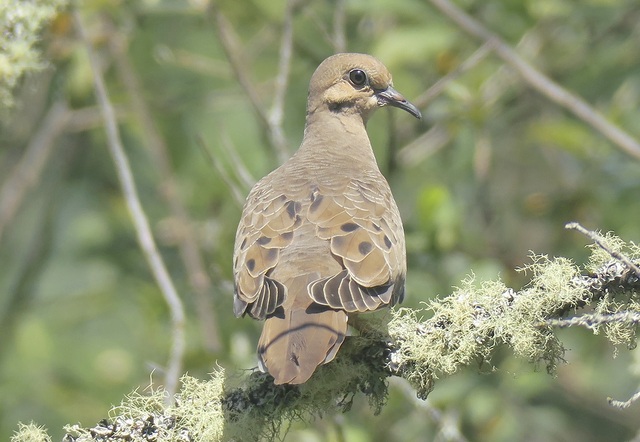I chose this photo of a Mourning Dove, taken by Mike Hamilton, specifically to show the back and back of the neck. Note the color of the back of its neck and the spots on its upper wings. These doves are quickly disappearing from the area thanks to the fairly recent influx of the Eurasian Collared Dove, a larger and more aggressive bird.
General Description: Most of us grew up hearing Mourning Doves cooing from the power lines in our neighborhoods. They are also a favorite of hunters, so a lot of us also ate one or two. At approximately 12 inches in length, with a wingspan of 18 inches and weighing just over 4 ounces, this dove is more slender than other Washington state doves. It is a grayish-tan with a buff-colored belly, light gray wings, a long pointed tail, black spots on the upper wings of the adult birds, a black beak, black eye, and orange legs.
Habitat: Mourning Doves are birds of open areas but like the edges where fields meet forests. They perch on power lines and usually feed on the ground, and are particularly fond of the grain fields of eastern Washington. Here on the wet side we find them along the sides of the roads and under our feeders.
Behavior: Mourning Doves are ground feeders, scrounging in the dirt for seeds. They gather in post-breeding flocks before migrating in late July-August. When they leave a perch their wings make a sharp whistling or whinnying sound.
Diet: The diet of these doves is 99 percent seeds. Most commercial birdseed is just fine with them as they prefer millet, one of the main ingredients in the feed. Scatter it on the ground near brushy edges or on a platform feeder off the ground to protect them from roaming cats. You may also see them swallowing grit to help them digest the hard grains.
Nesting: These are prolific breeders, with a single pair producing up to three broods per year in the Pacific Northwest, and up to six broods per year in warmer climates. The male shows the female some of the nest sites he has picked out, she chooses one, he brings nesting materials and she builds the nest of twigs in a tree or even on the ground. Both parents incubate two eggs for two weeks, then both feed the young a mix of protein and fat-rich liquid produced in their crops. The young leave the nest after two weeks but stay nearby for another two weeks so their parents can continue to feed them for another 1-2 weeks.
Migration: Many birds overwinter in their breeding range, but those that fly south are usually gone by October. They return north in March or April.
Conservation Status: The Mourning Dove is the most wide-spread and abundant gamebird in North America, and is also the most frequently-hunted species, which helps to keep their population in check.
When and Where to Find in Grays Harbor: These doves are found locally in lower elevations most of the year, so look for them on power lines in your neighborhood, or at a feeder tray, or on the ground under feeders. I recommend getting to know their call and compare it to their Eurasian cousin.
Listen here: Also be sure to listen to the two calls here: https://www.allaboutbirds.org/guide/Mourning_Dove/sounds and https://www.allaboutbirds.org/guide/Eurasian_Collared-Dove/sounds


